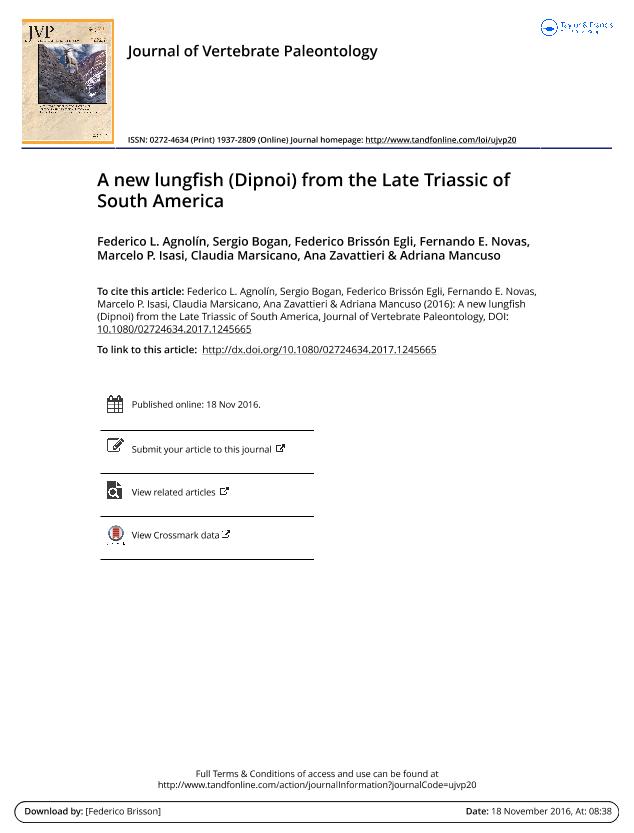Artículo
A new lungfish (Dipnoi) from the Late Triassic of South America
Agnolin, Federico ; Bogan, Sergio; Brisson, Eli Federico; Novas, Fernando Emilio
; Bogan, Sergio; Brisson, Eli Federico; Novas, Fernando Emilio ; Isasi, Marcelo Pablo
; Isasi, Marcelo Pablo ; Marsicano, Claudia Alicia
; Marsicano, Claudia Alicia ; Zavattieri, Ana Maria
; Zavattieri, Ana Maria ; Mancuso, Adriana Cecilia
; Mancuso, Adriana Cecilia
 ; Bogan, Sergio; Brisson, Eli Federico; Novas, Fernando Emilio
; Bogan, Sergio; Brisson, Eli Federico; Novas, Fernando Emilio ; Isasi, Marcelo Pablo
; Isasi, Marcelo Pablo ; Marsicano, Claudia Alicia
; Marsicano, Claudia Alicia ; Zavattieri, Ana Maria
; Zavattieri, Ana Maria ; Mancuso, Adriana Cecilia
; Mancuso, Adriana Cecilia
Fecha de publicación:
11/2016
Editorial:
Society of Vertebrate Paleontology
Revista:
Journal of Vertebrate Paleontology
ISSN:
0272-4634
Idioma:
Inglés
Tipo de recurso:
Artículo publicado
Clasificación temática:
Resumen
Lungfishes belong to the sarcopterygian clade Dipnoi. Livingforms are represented by three genera distributed among SouthAmerica, Africa, and Australia. The oldest fossil record of lungfishesis Devonian (see Long, 2010), but they become notablyabundant in post-Paleozoic deposits (Martin, 1982; Schultze,2004). The oldest South American records of fossil lungfishescome from Permian beds in Brazil (Cox and Hutchinson, 1991;Toledo and Bertini, 2005; Toledo, 2006). These specimens consistof isolated tooth plates assigned to Ceratodontidae and Gnathorizidae.Triassic finds are restricted to a single and incompletetooth plate from the Santa Marıa Formation (Carnian) of Brazil(Richter and Toledo, 2008). The specimen was referred to Ptychoceratodus,being probably related to the European form P.phillipsi. Because of the paucity of the record, Triassic SouthAmerican lungfishes almost completely lack mention in mostpaleobiogeographical analyses of early Mesozoic dipnoan distributionand radiation. In Jurassic beds, the record is restricted toisolated plates belonging to Ceratodus and ?Arganodus? from isolatedlocalities in Brazil and Uruguay (Soto and Perea, 2010). Incontrast, the Cretaceous and Paleogene lungfish record is especiallyabundant and diverse (Fernandez et al., 1973; Pascual andBondesio, 1976; Toledo and Bertini, 2005; Apesteguıa et al.,2007; Cione et al., 2007, 2010; Agnolin, 2010; Cione and Gouiric,2012; Alves et al., 2013).Here, we expand the record of South American dipnoans,describing a tooth plate and associated jaw bone from the LateTriassic (Carnian) Potrerillos Formation at the Agua de las Avispasfossiliferous locality, Mendoza Province, Argentina (Fig. 1).This is a well-known fossiliferous spot that has yielded a largenumber of plant and arthropod specimens, as well as fragmentaryactinopterygian material (Zavattieri and Pramparo, 2006;Morel et al., 2010; Gallego et al., 2011; Lara et al., 2012). Thespecimen here described is assigned to a new species of the widespreadgenus Ptychoceratodus and is the most complete Triassicdipnoan from South America.
Palabras clave:
Dipnoi
,
Triassic
,
Argentina
Archivos asociados
Licencia
Identificadores
Colecciones
Articulos(IANIGLA)
Articulos de INST. ARG. DE NIVOLOGIA, GLACIOLOGIA Y CS. AMBIENT
Articulos de INST. ARG. DE NIVOLOGIA, GLACIOLOGIA Y CS. AMBIENT
Articulos(MACNBR)
Articulos de MUSEO ARG.DE CS.NAT "BERNARDINO RIVADAVIA"
Articulos de MUSEO ARG.DE CS.NAT "BERNARDINO RIVADAVIA"
Citación
Agnolin, Federico; Bogan, Sergio; Brisson, Eli Federico; Novas, Fernando Emilio; Isasi, Marcelo Pablo; et al.; A new lungfish (Dipnoi) from the Late Triassic of South America; Society of Vertebrate Paleontology; Journal of Vertebrate Paleontology; 37; 1; 11-2016; 1-6
Compartir
Altmétricas



